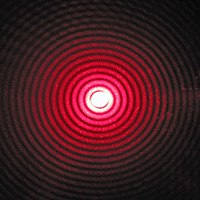
Photo from wikipedia
We present a numerical investigation of directly fiber-coupled hybrid circular Bragg gratings (CBGs) featuring electrical control for operation in the application relevant wavelength regimes around 930 nm as well as… Click to show full abstract
We present a numerical investigation of directly fiber-coupled hybrid circular Bragg gratings (CBGs) featuring electrical control for operation in the application relevant wavelength regimes around 930 nm as well as the telecom O- and C-band. We use a surrogate model combined with a Bayesian optimization approach to perform numerical optimization of the device performance which takes into account robustness with respect to fabrication tolerances. The proposed high-performance designs combine hybrid CBGs with a dielectric planarization and a transparent contact material, enabling > 86% direct fiber coupling efficiency (> 93% efficiency into NA 0.8) while exhibiting Purcell factors > 20. Especially the proposed designs for the telecom range prove robust and can sustain expected fiber efficiencies of more than (82.2±4.1)-5.5+2.2% and expected average Purcell factors of up to (23.2±2.3)-3.0+3.2 assuming conservative fabrication accuracies. The wavelength of maximum Purcell enhancement proves to be the most affected performance parameter by the deviations. Finally, we show that electrical field strengths suitable for Stark-tuning of an embedded quantum dot can be reached in the identified designs. Our work provides blueprints for high-performance quantum light sources based on fiber-pigtailed and electrically-controlled quantum dot CBG devices for quantum information applications.
Journal Title: Optics express
Year Published: 2022
Link to full text (if available)
Share on Social Media: Sign Up to like & get
recommendations!